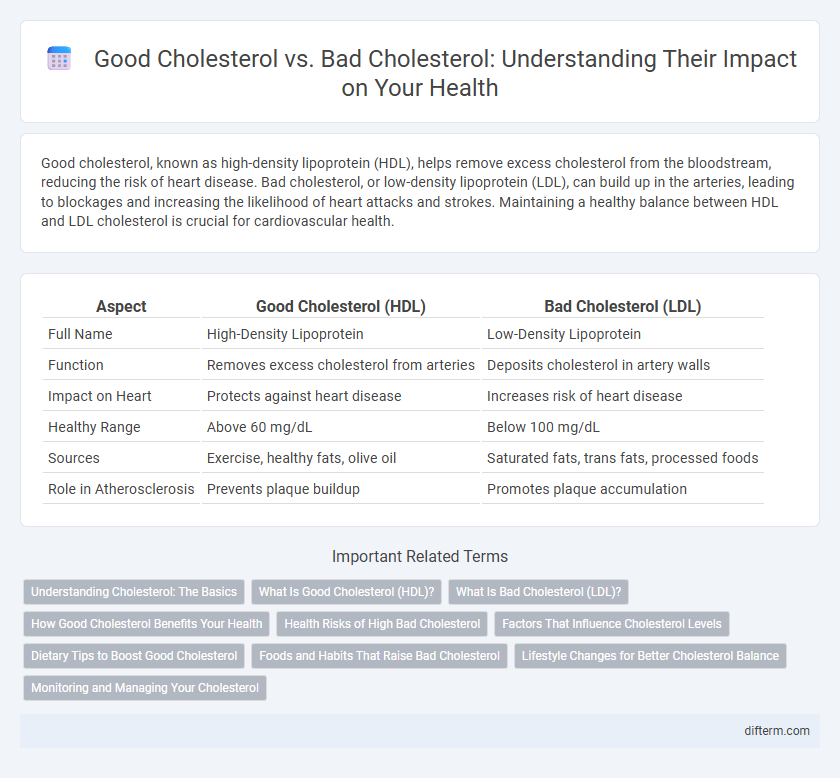Good cholesterol, known as high-density lipoprotein (HDL), helps remove excess cholesterol from the bloodstream, reducing the risk of heart disease. Bad cholesterol, or low-density lipoprotein (LDL), can build up in the arteries, leading to blockages and increasing the likelihood of heart attacks and strokes. Maintaining a healthy balance between HDL and LDL cholesterol is crucial for cardiovascular health.
Table of Comparison
| Aspect | Good Cholesterol (HDL) | Bad Cholesterol (LDL) |
|---|---|---|
| Full Name | High-Density Lipoprotein | Low-Density Lipoprotein |
| Function | Removes excess cholesterol from arteries | Deposits cholesterol in artery walls |
| Impact on Heart | Protects against heart disease | Increases risk of heart disease |
| Healthy Range | Above 60 mg/dL | Below 100 mg/dL |
| Sources | Exercise, healthy fats, olive oil | Saturated fats, trans fats, processed foods |
| Role in Atherosclerosis | Prevents plaque buildup | Promotes plaque accumulation |
Understanding Cholesterol: The Basics
Cholesterol is a lipid molecule critical for cell membrane structure and hormone production, existing primarily as high-density lipoprotein (HDL) and low-density lipoprotein (LDL). HDL, often referred to as "good cholesterol," helps remove excess cholesterol from the bloodstream, reducing the risk of cardiovascular diseases. In contrast, LDL, known as "bad cholesterol," can accumulate in arterial walls, leading to plaque formation and increased risk of heart attacks and strokes.
What Is Good Cholesterol (HDL)?
High-density lipoprotein (HDL), commonly known as good cholesterol, plays a crucial role in cardiovascular health by transporting excess cholesterol from the arteries to the liver for excretion or recycling. Elevated HDL levels are associated with a lower risk of heart disease and stroke due to its anti-inflammatory and antioxidant properties. Maintaining HDL cholesterol above 60 mg/dL is recommended to effectively reduce plaque buildup and promote arterial health.
What Is Bad Cholesterol (LDL)?
Low-Density Lipoprotein (LDL), commonly known as bad cholesterol, contributes to plaque buildup in arteries, increasing the risk of heart disease and stroke. High levels of LDL cholesterol lead to atherosclerosis, a condition characterized by narrowed and hardened arteries that restrict blood flow. Monitoring and managing LDL cholesterol through diet, exercise, and medication is crucial for cardiovascular health.
How Good Cholesterol Benefits Your Health
Good cholesterol, also known as high-density lipoprotein (HDL), helps remove excess cholesterol from arteries, reducing the risk of heart disease and stroke. Higher levels of HDL cholesterol are associated with improved cardiovascular health by transporting cholesterol to the liver for elimination. Maintaining optimal HDL levels supports overall heart function and lowers the likelihood of arterial plaque buildup.
Health Risks of High Bad Cholesterol
High levels of low-density lipoprotein (LDL) cholesterol, known as bad cholesterol, significantly increase the risk of atherosclerosis, heart attacks, and strokes by promoting plaque buildup in arteries. Elevated LDL cholesterol contributes to coronary artery disease and can lead to decreased blood flow, causing severe cardiovascular complications. Maintaining optimal cholesterol balance by reducing LDL levels is crucial for preventing long-term health risks associated with poor cardiovascular outcomes.
Factors That Influence Cholesterol Levels
Dietary choices significantly influence cholesterol levels, with saturated and trans fats raising bad cholesterol (LDL) and soluble fiber from fruits and vegetables enhancing good cholesterol (HDL). Physical activity elevates HDL, while smoking and excessive alcohol intake tend to increase LDL and lower HDL concentrations. Genetic factors also affect cholesterol metabolism, making personalized lifestyle modifications essential for optimal cardiovascular health.
Dietary Tips to Boost Good Cholesterol
Increasing intake of omega-3 fatty acids found in fatty fish, flaxseeds, and walnuts helps raise high-density lipoprotein (HDL) cholesterol, the "good" cholesterol that supports heart health. Consuming soluble fiber from oats, fruits, and legumes reduces low-density lipoprotein (LDL) cholesterol, lowering the risk of arterial plaque buildup. Replacing saturated fats with healthy monounsaturated fats present in olive oil, avocados, and nuts further enhances HDL levels and promotes balanced cholesterol profiles.
Foods and Habits That Raise Bad Cholesterol
Consuming foods high in trans fats, such as fried items, processed snacks, and baked goods with hydrogenated oils, significantly raises LDL (bad) cholesterol levels. Habits like excessive alcohol consumption, smoking, and a sedentary lifestyle further contribute to the elevation of harmful cholesterol in the bloodstream. Incorporating a diet rich in fiber, lean proteins, and regular physical activity can help mitigate these negative effects and promote cardiovascular health.
Lifestyle Changes for Better Cholesterol Balance
Incorporating regular physical activity and adopting a heart-healthy diet rich in soluble fiber and healthy fats can significantly improve cholesterol balance by raising HDL (good cholesterol) and lowering LDL (bad cholesterol) levels. Limiting intake of trans fats, processed foods, and refined sugars supports healthier lipid profiles and reduces cardiovascular risks. Maintaining a healthy weight and avoiding smoking further contribute to optimizing cholesterol levels and promoting overall cardiovascular health.
Monitoring and Managing Your Cholesterol
Monitoring your cholesterol levels through regular blood tests helps distinguish between high-density lipoprotein (HDL) known as good cholesterol, and low-density lipoprotein (LDL) or bad cholesterol. Managing cholesterol involves lifestyle changes such as a heart-healthy diet rich in fiber and healthy fats, regular physical activity, and, when necessary, medications prescribed by healthcare professionals. Keeping LDL levels low and HDL levels high reduces the risk of cardiovascular diseases and supports overall heart health.
Good Cholesterol vs Bad Cholesterol Infographic

 difterm.com
difterm.com